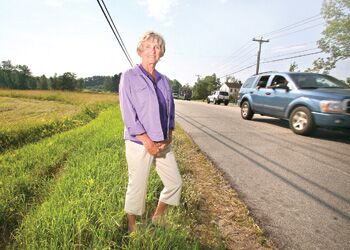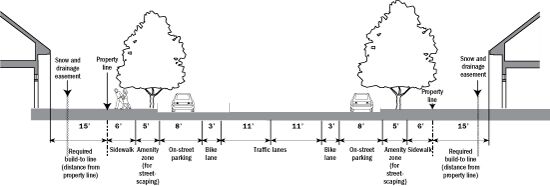Form-based codes | A new zoning philosophy gets a toehold in Standish
Six years ago, when a developer proposed building a gas station and fuel delivery operation on Route 25 in Standish’s village district, citizens fought the project. It was hugely controversial, says Carol Billington, who at the time was chair of the planning board. No one wanted a huge gas station, yet the zoning permitted it.
Pit Stop Fuels was ultimately approved, with numerous restrictions. And while resentment toward it has faded (Now people like it, Billington says), efforts to guide development in the town’s historic center have intensified. After four years of planning, town officials are finally implementing a new Standish Corner Village master plan, and to do that, they’ve turned to a regulation known as a form-based code. More common in sprawl-heavy states like Florida and California, this alternative to typical municipal zoning emphasizes form over function. Standish recently became the first municipality in Maine to adopt a form-based code, which town officials say will help the Standish Corner District grow into a pedestrian- and business-friendly village center, instead of an automobile-focused throughway where people stop to fill up — and then keep driving.
If you look at the historic nature of New England [villages], we created that sense of community, and all that’s kind of gone away, Billington says. We’re trying to resurrect that a little bit.
Whereas traditional use-based zoning, also known as Euclidean zoning, focuses on segregating uses, form-based codes focus on a building’s size and placement in relation to the street and other buildings around it. The objective is to recreate the look of a traditional New England village, where people can park and walk easily to shops, restaurants, doctors’ offices and more. An emphasis on mixed-use developments allows people to live in the village district, seen as key to its economic vitality. Businesses aren’t coming if you don’t have the population base to support it, and they’re not coming if you make them buy three acres for one business and build 90 parking spaces, says Billington.
Developed with the help of nonprofit GrowSmart Maine, Yarmouth planning firm MRLD and form-based codes expert Alan S. Manoian, Standish Corner’s new code aims to ensure development fits with the feel of the existing village and the town’s desires for the 4-square-mile swath of land stretching from the intersection of routes 25 and 35. At least 100 businesses occupy the corner district, including a hardware store, tanning salon, couple of banks and health care offices, and a Hannaford store.
Form-based codes are new to the region in part because New England already has such a rich heritage of town-building and a historical legacy that [towns] probably haven’t felt there to be a need for it until recently, says Alan Mammoser, program director of the Form-Based Codes Institute in Chicago. Form-based codes are really effective in the redevelopment of an area, or an older neighborhood with empty lots, or an open piece of land contiguous to a town, he says.
A number of communities in Maine are looking to form-based codes to turn quality of place into an economic engine, including Bridgton, Naples, Kennebunk and Belfast. Manoian, Bridgton’s economic and community development director, is the only planner in Maine and New Hampshire certified by the Form-Based Codes Institute and regularly presents around the state on the topic. Bridgton, which currently has no zoning at all, plans to put a code for its downtown district to public vote in November. But not all towns are singing the code’s praises. Residents in Damariscotta last month voted against installing a form-based code in three areas of the town.
Conventional use-based zoning is proscriptive, or what you can’t do, says Manoian. But with a form-based code, the whole premise is prescriptive — this is how you want the street to function.
For many communities, Standish included, modern zoning and its rules on setbacks and parking requirements has led to strip mall-like developments: major roads lined with box-like, single-story buildings set far away from the road, fronted by expansive asphalt lots and no sidewalks. Use-based zoning isolates, segments, separates uses, becoming low-density, sprawling, auto-oriented development zones that just look like Nowhere, Anywhere USA, Manoian says.
Form-based code in detail
Standish Corner district's form-based code uses illustrations like this to show where buildings and parking should be located to emphasize a walkable village
An appealing village center compels people driving through to slow down, increasing visibility for businesses that otherwise would struggle to attract clientele along the busy strip, says Maria Smith, who owns hair salon Studio 25 on Route 25. I’m hoping small businesses will shoot up and have a true chance of making it, she says. The form-based code allows for growth without having this huge, overwhelming development in the village center, and it keeps its pretty appeal that way.
Positioning for better times
The past few years have not been kind to Standish. Its population, in 2006 projected to grow to 13,000, has dipped below 10,000 as of the 2010 Census. Nothing new is being built here, says Billington, now vice-chair of the planning department and a member of the committee that developed the corner district plan. There’s been very little measurable growth and almost no new businesses.
The code came out of the town’s new comprehensive plan, adopted in 2006, after town officials discovered that only 10% of Standish’s growth over the previous decade occurred in areas identified for development. Approved by the town council in June, the code lays out rules for development in various sectors of the corner district. Changes include shrinking the minimum lot size requirement in some places from 80,000 square feet to 20,000 square feet, and relaxing parking-space requirements. Instead of setback requirements, lots have a build-to line, ensuring buildings are placed close to the street for easy pedestrian access. If buildings do have parking lots, they’re moved to the back to not disrupt the streetscape. The code even requires that building fronts have a certain percentage of windows, called fenestration, to create a more welcoming vibe.
The code gives more value to landowners, who can break their property into smaller chunks and sell to more people, and developers and business owners don’t need to buy as much land. The code is also easier for developers to understand, say proponents. Many are no more than 20 pages, says Manoian, and are illustration heavy.
Hair salon owner Smith, who is on the village implementation committee, bought the one-story former residence that houses her business three years ago. Under the new code, she can now build a second and maybe third floor to her building to add office space or apartments, enhancing its value.
And she doesn’t dread development in the field next door to her business, especially now that we have the code to keep it more like a village. A great big cement block building with no character or charm would be horrible.
But changes won’t happen overnight. This is a long-term planning effort, says Billington. If I see big changes in my lifetime, I think I’ll be lucky. The town will start by building sidewalks, and has won a $59,000 federal grant to fund engineering studies for the project.
And though the town has struggled to attract businesses, Billington sees a silver lining. Four large parcels in the corner district have sat vacant for years. Now, with the new code in place, those tracts will be developed in line with the town’s vision for its economic future. Now they’ll be much different than they would have been, she says. In one way I guess the recession hit Standish at a good time.
No consensus in Damariscotta
The story is different in the midcoast town of Damariscotta. When the Damariscotta Planning Advisory Commission in 2009 set out to develop a form-based code for parts of the town, it did everything it could to keep the town’s residents informed. It sent regular updates to an email list of 800 people and posted them in the local newspaper. The town manager sat in a coffee shop every Friday morning to field questions on the code. It held 41 workshops to find out how residents envisioned Damariscotta’s future, and tapped the help of consultants and the Orton Family Foundation, which gave the town a $100,000 grant as part of its program to help communities guide development.
Robin Mayer, head of DPAC, acknowledges some people still had questions about the code come voting day. Unlike in Standish, where the code only needed approval from the town council, Damariscotta’s had to pass muster with 2,200 residents. Some were opposed to a proposed development on a 260-acre tract of land near the downtown, one of the areas that would have been governed by the code and the only place identified in the town’s comprehensive plan as ideal for growth. The code also would have applied to downtown and a stretch along Route 1B that a group of developers has proposed turning into a village-style development known as Piper Common. The measure failed by a vote of 301 to 127. It was viewed as diminishing the downtown village center, Mayer says.
John Reny, president of Maine-based discount retailer Reny’s, which has a store downtown, is wary of developers’ plans for Piper Common, and questions the need for change. I think things have worked pretty good over the years, he says. We’ve stayed a very viable downtown and a viable community.
But Mayer, who moved to Damariscotta five years ago, worries that unless residents accept some changes, the town will grow into exactly what they don’t want. The committee plans to survey voters to find out why they didn’t approve the code, in the hopes of better aligning it to residents’ desires. If they just don’t want growth, though, that’s not so easy to fix, she says. Then it’s about educating people that we’re going to grow. You can’t stop growth. Do we want developers to dictate how we grow?
Mindy Woerter, Mainebiz e-news editor, can be reached at mwoerter@mainebiz.biz.












Comments